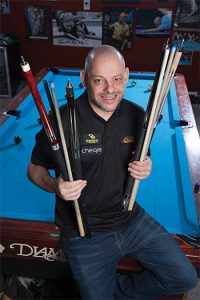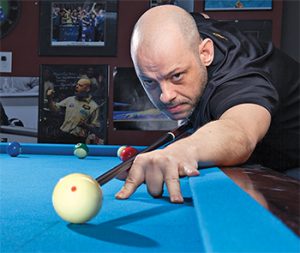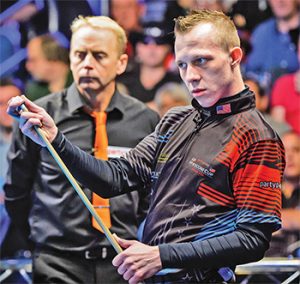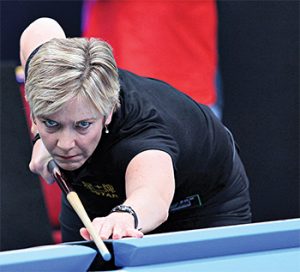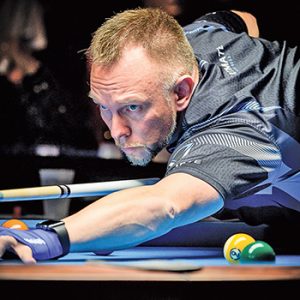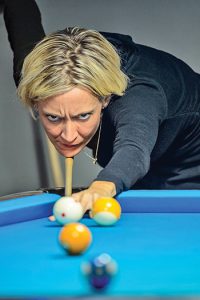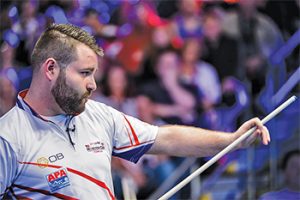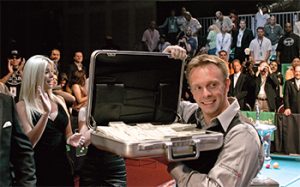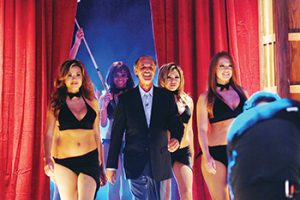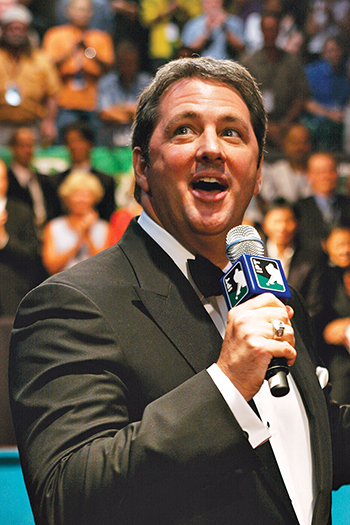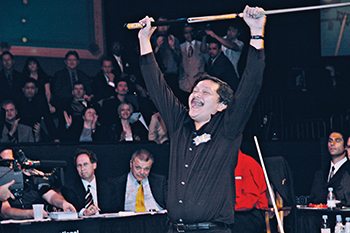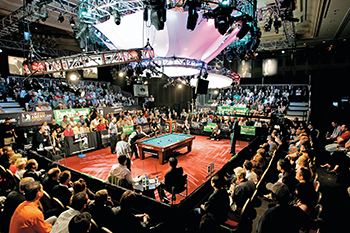Player of the Year
On Men: Joshua Filler
Joshua Filler’s 2023 was a year of quality and quantity. The world-traveling superstar collected nine big wins, headlined by titles at the Qatar Open, the China Open, and the World Pool Team Championship. Filler outshined Ping Chung Ko, who had an equally impressive 2023 with wins at the U.S. Open Pool Championship and Maldives Open, and outearned Fedor Gorst, runner-up on the money list, by more than $50,000, collecting three wins on the always-competitive EuroTour. The Killer’s 2023 Player of the Year campaign was obviously great for him — but look closer and you can see positives for the sport as a whole. His total earnings of $328,446 proved the largest one-year haul since 2006 and the days of the International Pool Tour.
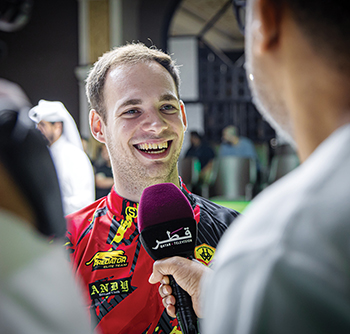
Women: Kelly Fisher
Three years after her induction into the Billiards Congress of America Hall of Fame, Kelly Fisher is still shooting her way to the top of the game. She topped the women’s money list, according to AZBilliards.com, with a tournament earning total of $97,550 to Chou Chieh-Yu’s $95,313. While Chou bagged the biggest payday of the year of $30,000 at the Women’s World 9-Ball Championship, Fisher was consistently great from January to December. In five WPBA Classic Tour events, she won three (Fairfield Invitational and two Iron City Invitationals) and finished runner-up at a fourth (Masters). Add a $22,500 title at the Puerto Rico Open and Fisher proved worthy of her seventh BD Player of the Year award (and third “on the trot”).

Performance of the Year
Women: Jasmin Ouschan at WPBA Masters
Jasmin Ouschan took her second straight and fourth overall WPBA Masters title in July. Not only did she repeat, the 38-year-old Austrian beat the same opponent (Kelly Fisher) by the same score (10-8), while Margaret Fefilova Styer finished third in both events. Long one of the most fearsome players in the women’s game, Ouschan proved she’s still plenty to handle at the table, winning this event along with the 2023 WPBA Aramith Dr. Pool Classic in December.
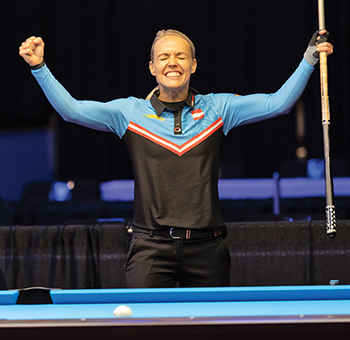
Men: Fedor Gorst at DCC
Newly minted U.S. resident and member of Team USA in the Mosconi Cup, Fedor Gorst had a field day at perhaps the most American of pool events. At January’s Derby City Classic, he took home his second Master of the Table award by notching victories in both the 9-ball division and 9-ball banks, which was also a repeat performance. Cashing in for $52,300, Gorst pushed his physical limits, enduring day-and-night tournament schedules with a little help from caffeine and sugar. His win over Shane Van Boening in the 9-ball division final came at 9:30 a.m. on Sunday, 12 hours after it was originally scheduled. Hopefully some of that prize money went into a well-earned vacation.
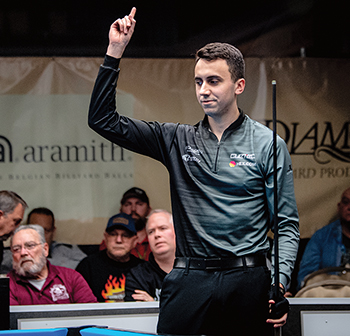
Breakout Player of the Year
Men: Moritz Neuhausen
By definition, to some extent, it’s difficult to guess the breakout player of the year in January. When it comes to Moritz Neuhausen, you could see the seeds of something big in his 2022. He won the Euro Championships Under 23 9-Ball event and cashed in events like the U.S. Open and EuroTour stops. But 2023 saw the 20-year-old German take two steps forward. He shared the World Team Championship with Pia and Joshua Filler, finished second in the World Cup of Pool (again with Joshua Filler), and nabbed a few regional events on American soil. All in all, Neuhausen positioned himself as the next great young German.
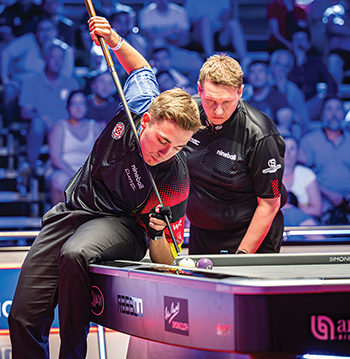
Women: Pia Filler
Speaking of strong young Germans, Pia Filler stepped up her game up as well in 2023. The better half of a pool-shooting partnership that has a promising few decades ahead of it, the 25-year-old pocketed that World Team Championship title, but also won the Euro Championships Women’s 9-Ball division and finished second in 10-ball. Filler proved impressively consistent on the international level, turning in strong performances with a third-place finish at the China Open, two runner-up runs on the EuroTour, and ninth-place turns at the World 9-Ball and 10-Ball Championship.

The “Money Fixes Everything” Award: Snooker’s Match Fixing Scandal
Sportsbooks are ubiquitous in professional sports, with major players advertising in seemingly every way possible. Betting on pool would surely raise interest, right? There might be more to it. In January 2023, two Chinese snooker players were suspended for “manipulating” matches, raising the total of suspension for match fixing to 10. Pool and gambling have gone hand in hand for, well, forever. But an influx of cash and interest from outside the sport could present a suitcase of problems that might be more complicated than online gambling proponents might expect.
The Lifer Award/Person of the Year: Mike Zuglan
Consider this an appreciation of a lifetime of work in pool. Mike Zuglan has carved out his own little niche in the Northeast U.S., where he runs his tour and its biennial Turning Stone Classic events–all on his own terms. First a pro player in the golden age of modern pool in the 1970s and 1980s, the straight-talking New Yorker is now an elder statesman in pool tour promotion and organization. Despite recent health struggles along with a global pandemic, Zuglan keeps chugging along. Here’s to plenty of track left on that route.
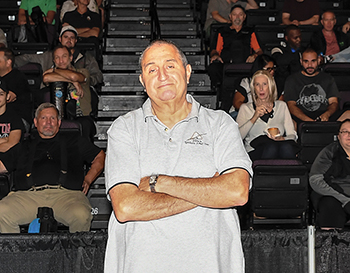
“The Road Less Traveled” Award: Eklent Kaci
Shortly after winning his second World 10-Ball Championship, 24-year-old Eklent Kaci hit a literal bump on the road to the best season in an already-impressive career. The young superstar sustained a host of injuries in an off-roading accident in Macedonia. His vehicle flipped in a turn, leaving Kaci with two broken bones in his left arm, torn tendons, and muscle damage. After multiple surgeries and two months of recovery, Kaci entered the World 8-Ball Championships and finished in the top eight, serving notice that the defending World 10-Ball champ will once again be a force in 2024.

The “Here’s to a Healthy 2024 and Beyond” Award: Darren Appleton & Mika Immonen
Health issues for two of the youngest BCA Hall of Famers shocked the pool community, before it rallied around its superstars. Darren Appleton was a walking inspiration throughout 2023, as the 47-year-old recovered from a heart attack in December 2022 and began appearing at pool events and competing. The example is one that might come in handy for Mika Immonen, who announced in December 2023 that he had been diagnosed with Stage IV colon cancer. Just 51 years old and always healthy and fit, the Finn has promised to win the highest stakes match of his life. The pool world, meanwhile, is in his corner, with a GoFundMe to help offset the Iceman’s hefty medical bills blowing past its initial goal of $50,000, topping $89,000 in mid-January. Darren’s working his way back and here’s hoping Mika won’t be far behind.

The “The Terminator Ends His Wait” Award: Niels Feijen’s Induction into BCA Hall of Fame
Niels Feijen booked his ticket into the BCA Hall of Fame in 2023, garnering 79% of votes on his fifth go-around on the ballot. The steely Dutchman has compiled an impressive resume in his two decades as an international pro, including two world titles–the 2008 World Straight Pool Championship and 2014 World 9-Ball Championship. The 46-year-old has especially thrived in Matchroom competitions, winning the World Pool Masters twice (2013 and 2018) and making 14 appearances in the Mosconi Cup, where he’s collected eight wins and four MVP awards.
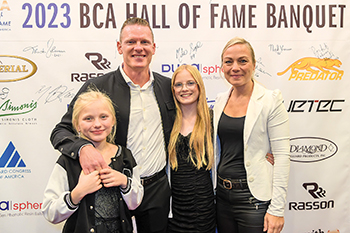
“The World Is Yours?” Award: WPA-Matchroom Power Struggle
With Matchroom Pool moving forward with an ambitious plan to launch a worldwide 9-ball tour, the World Pool Association, the sport’s longtime global governing body, had to respond in some way. Just how came in the fall as WPA leadership announced that any players who participated in non-WPA-sanctioned events — read: Matchroom’s new World Nineball Tour — would be suspended from WPA events. While many wondered what impact this might have on players from European and Asian countries with strong national governing bodies, top-line talent appears committed to Matchroom, leaving many wondering if this power struggle has reached a critical mass in favor of the U.K.-based promotions outfit.
The “A House Divided…” Award: The Billiards Industry
After years of tension, politicking and heated debates, the billiards industry split itself over two trade shows in 2023. The BCA Expo folded into the Amusement Expo International show, while the Billiard Industry Group, founded in 2022, jumped to the Hearth, Patio and Barbeque Expo, with both meetings taking place in March. In the end, neither show impressed exhibitors and buyers, leaving many in the business calling for a renewed effort for unity. Détente was achieved in late 2023, and the industry will exhibit as one at the Amusement Expo in Las Vegas in March.
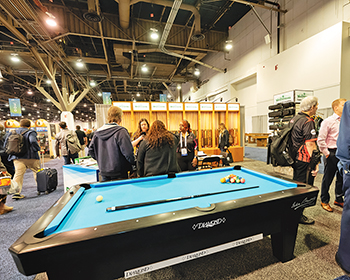
The “Behind Every Great Man” Award: Amy Lee Jones
After a disappointing Mosconi Cup for Team USA, Jeremy Jones visited with the Window’s Open podcast from his Dallas-area home to discuss what went wrong (a lot) and what went right (not enough). During the interview, JJ’s better half chimed in on the podcast’s Facebook page with, “Jeremy, blink twice if you want me to turn off the Wi-Fi.” Might be time to update that axiom to, “Behind every great man is a woman willing to bust his chops.”

The “Show Me the Money” Award: Sponsorships in Pro Pool
The expanding number and prestige of events across the world, driven primarily by Matchroom and Predator, has improved the bottom line for plenty of professional players. But in addition to the cash earned at the table, top performers are also seeing renewed interest from major brands in sponsorship deals. Considering the sales boom in the wake of the COVID-19 pandemic, many companies are looking to improve visibility with agreements with stars. Fedor Gorst, Oscar Dominguez, Jonas Souto, Francisco Sanchez-Ruiz and junior champ Savannah Easton all inked new deals in 2023. More events, more visibility, more sales — the type of feedback loop that pool has sought for years.
Photo of the Year: Pia Filler — World Teams Championship
This could also double as the “Behind Every Great Man Award II.” With the title match of the World Teams Championship having been extended to sudden death spot shots, all-world Joshua Filler’s 25-year-old wife Pia stepped to the table with a chance to secure the crown and the $120,000 top prize. “Joshua told me, ‘Just go make it,’” Pia recalled with a laugh. And so she did, leading to this celebratory moment captured by Matt Porinsky/Coin Flip Photography.
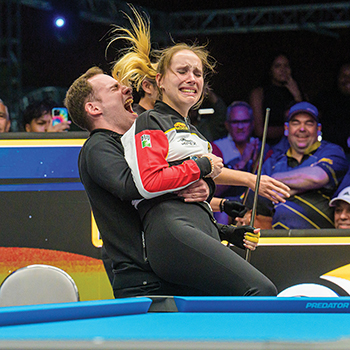
The “RIP to a Real One” Award: Danny Basavich
In a sport full of characters, Danny Basavich was a personality with an almost literal gravitational pull. But his story ended too soon, when the 44-year-old passed away in May. Dubbed “Kid Delicious,” Basavich grew into a legend when it came to money games, traveling up and down the Eastern Seaboard with his road partner Robert “Bristol Bob” Begey. His exploits were eventually covered by Sports Illustrated’s Jon Wertheim in a 2004 article and the ensuing book, “Running the Table — The Legend of Kid Delicious.”
The “It’s Worth What Someone Will Pay For It” Award: Paul Newman’s Cue
“Fast Eddie” Felson was a fictional character, but the cue used by Paul Newman’s character in “The Hustler” and “The Color of Money” fetched real cash in a June 2023 auction. Selling a host of items from the estate of Newman and wife Joanne Woodward, Sotheby’s originally valued the cue — a Joss-made “Balabushka” with playing card inlays and ”Fast Eddie Felson” inscribed on the collar ring — at $2,000-$3,000. But once open for sale, the cue fetched an eye-popping $76,200. Interestingly enough, two cues Newman actually used in ”The Hustler” only brought in $4,826.



